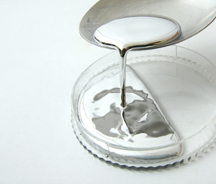Part III – Gold Rush: Mercury and its Various Forms
 In part two of our Mercury blog post, we described Mercury and provided some initial details on the various forms of the element. In this post, we will go into more detail elemental, inorganic and organic forms of mercury.
In part two of our Mercury blog post, we described Mercury and provided some initial details on the various forms of the element. In this post, we will go into more detail elemental, inorganic and organic forms of mercury.
Elemental Mercury
Mercury in elemental form is a silver-colored liquid that remains liquid at room temperature. Inorganic mercury is mined and processed to generate elemental mercury[i]. It is poorly absorbed by ingestion and contact with skin, and ingested elemental mercury is not absorbed in significant quantities[ii]. Because elemental mercury is absorbed slowly, a majority of it passes the digestive system without doing significant harm.
Elemental mercury evaporates easily into the air at room temperature forming a mercury vapor. Consequently, the primary risk of mercury exposure from elemental mercury is via inhalation of mercury vapor where it is absorbed through the respiratory system to the circulatory system. Inhalation can cause numerous cognitive, personality, sensory and motor disturbances.[iii]
Elemental mercury is used for the extraction of gold ore (refer to the first blog on mercury contamination from the California Gold Rush of this series), chlorine gas production, and in thermometers, barometers, electric switches, fluorescent light bulbs, dental amalgams fillings, and some medical advices. Strangely enough, liquid elemental mercury (also called azogue) is also used in ritualistic religious practices, a risk serious enough to warrant the designation of a specific USEPA task force[iv].
Inorganic Mercury Compounds
Inorganic Mercury compounds primarily affect the gastrointestinal system and kidneys. Unlike other forms of mercury, inorganic mercury compounds do not cause neurological damage without continuous or extreme levels of exposure. This is due primarily to their inability to cross the blood-brain barrier (a separation of the bodies circulating blood from brain fluid.(Wikipedia - mercury poisoning and blood brain barrier).
Forms of inorganic mercury compounds include mercuric cyanide [Hg(CN)2] and mercury (II) chloride (HgCL2).
Hg(CN)2 is extremely toxic mercury compound capable of causing both cyanide and mercury poisoning. Exposure to Hg(CN)2 can occur through inhalation, ingestion and via the skin. Health effects related to inhalation of Hg(CN)2 are mainly bronchial and respiratory. Skin contact results in skin allergy and irritation. Continued exposure to Hg(CN)2 can led to bioaccumulation and subsequent kidney damage, as well as a condition known as “the shakes”, a lack of fine motor control.[v]
Mercury(II) chloride (HgCL2), a mercury salt occurring in environmental sources, has unlikely potential for ingestion, but is known to cause damage to the gastrointestinal tract and kidney failure[vi].
Both mercuric cyanide [Hg(CN)2] and mercury (II) chloride (HgCL2) were used historically for a variety of applications including photography and medicine. Ironically, both were used as a treatment for syphilis prior to the advent of antibiotics. Both forms would often poison the patient to the degree that the effects of the mercury were often confused with the effects of the syphilis itself. (Wikipedia - Mercury chloride and Mercury Cyanide) Today, HgCL2 is most commonly used as a laboratory reagent to form an amalgam with metals[vii].
Organic Mercury Compounds
When mercury is deposited in water bodies, it can undergo a complex cycle of processes in which it is converted from one form to another. One of these processes is methylation, in which inorganic mercury is converted to methyl mercury, an organic mercury compound, by bacteria and microorganisms[viii]. It is important to note that within the same cycle of processes, mercury can also undergo demethylation.
Methyl mercury poses the greatest human health threat of all forms of mercury because it is capable of entering and accumulating in the food chain through fish and wildlife[ix] according to two principles:
- Bioconcentration - (where uptake of a substance is greater than its excretion) Fish in particular have the ability to bind more than 90% of their consumed methyl mercury[x].
- Biomagnification - (where the concentration of substance increases in the tissues of organisms at successively higher levels of the food chain.) Smaller fish will contain less mercury than larger fish.
When human beings are exposed to methlymercury by consuming contaminated fish, the body absorbs 90% of ingested methyl mercury[xi]. This is the most common form of mercury exposure[xii].
In part four of our Mercury post, we will focus on what happens to the human body when it is exposed to mercury.
[i] Environmental Protection Agency - TEACH Chemical Summary, http://www.epa.gov/teach/teachsummaries.html
[ii] Olson, David A. Mercury Toxicity; Chief Editor: Ramachandran, Tarakad S. Medscape.com. Updated March 8, 2013. http://emedicine.medscape.com/article/1175560-overview.
[iii] Wikipedia - Mercury Poisoning
[iv] Environmental Protection Agency - TEACH Chemical Summary, http://www.epa.gov/teach/teachsummaries.html
[v] (Wikipedia - Mercury Poisoning)
[vi] Mercury in the Environment; Publications - Fact Sheet 146-00 October 2000. U.S. Geological Survey. http://www.usgs.gov/themes/factsheet/146-00/
[vii] Wikipedia - Mercury chloride
[viii] Olson, David A. Mercury Toxicity; Chief Editor: Ramachandran, Tarakad S. Medscape.com. Updated March 8, 2013. http://emedicine.medscape.com/article/1175560-overview.
[ix] Mercury in the Environment; Publications - Fact Sheet 146-00 October 2000. U.S. Geological Survey. http://www.usgs.gov/themes/factsheet/146-00/
[x] Olson, David A. Mercury Toxicity; Chief Editor: Ramachandran, Tarakad S. Medscape.com. Updated March 8, 2013. http://emedicine.medscape.com/article/1175560-overview.
[xi] ibid
[xii] Mercury Contamination in Fish - Know Where It’s Coming From. Natural Resources Defense Council. http://www.nrdc.org/health/effects/mercury/sources.asp
